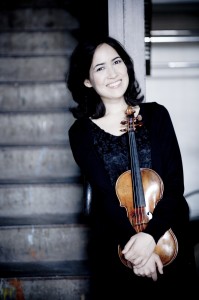A Rewarding Nielsen Fifth, but a Pallid Mendelssohn Concerto
Wars hot and cold dominated the 20th century, stirring composers’ imaginations in myriad ways. Stravinsky’s 1918 “The Soldier’s Tale” portrayed war as class conflict cynically abetted by religion, while Benjamin Britten’s 1962 “War Requiem” lamented the utter futility of armed conflict. On the other hand, Aaron Copland’s “Fanfare for the Common Man” and Samuel Barber’s “Symphony Dedicated to the Air Forces” were written as unabashed musical propoganda during the Second World War.
San Diego Symphony Music Director Jahja Ling and the orchestra gave a rich, probing account of Carl Nielsen’s Fifth Symphony at Copley Hall Friday (Jan. 11), a lesser known work in the genre of music inspired by war. Completed 3 years after the 1918 Armistice, Nielsen’s Fifth Symphony is a complex orchestral tapestry that depicts the forces of good and evil in unambiguous military imagery.
Dark, muscular brass choirs suffuse the ominous marching cadences that propel the work, and what other symphony can boast a raucous, provocative snare drum cadenza at its center?
If Nielsen’s symbolism is far from subtle, his compositional craft is deft and sophisticated. Unlike, say, Bruckner or Scriabin, this great Dane’s musical ideas never overstay their welcome, and his inventive thematic development never misses an emotional payoff. Happily, Ling’s pacing was right on the money, energetically unwrapping Nielsen’s manifold musical gifts with a keen sense of surprise and expectation.
Although Nielsen structured his symphony in two large movements—as opposed to the customary four—his sailing vessel is[php snippet=1] never becalmed. In the adagio section of the first movement, the orchestra produced a sonority of luxuriant breadth, a noblity worthy of Elgar, while the skittish fugue in the second movement sparkled with nimble articulation.
Every section of the orchestra had at least one moment of glory, but indulge me while I offer kudos to the trumpets. In the bucolic, string dominated opening of the second movement, Nielsen asks the trumpets to sneer a jarring countertheme. Given a chance to emit a piercing snarl, San Diego’s trumpets take a back seat to no one!
I wish I could be as enthusiastic about the young Bavarian violinist Viviane Hagner’s interpretation of the Mendelssohn E Minor Violin Concerto, but I found her approach pallid and bloodless. She proved an immaculate technician who delivered every flashy figuration with breathtaking precision.
But her Mendelssohn Concerto just sat on the Copley stage like a souffle that stubbornly refused to rise. As any half-awake music[php snippett=1] appreciation student knows, this concerto is the first great Romantic violin concerto of the repertory. Ms Hagner demonstrated Mendelssohn’s greatness, but I was hard-pressed to find much Romantic spirit in her playing.
Ling opened the concert with Rossini’s evergreen Overture to La gazza ladra, an apt choice for this program because of its prominent display of snare drum solos. And there was nothing perfunctory about his crisp, well-proportioned account of this overture.
[box] Violinist Viviane Hagner with the San Diego Symphony continues Jan. 12, 2013, at 8:00 p.m. and Jan. 13, 2013, at 2:00 p.m. in Copley Symphony Hall. Next S.D. Symphony concerts: pop singer Brian Stokes Mitchell appears with the orchestra Jan. 18 & 19, 2013, under the baton of Randall Craig Fleischer.[/box]

Ken Herman, a classically trained pianist and organist, has covered music for the San Diego Union, the Los Angeles Times’ San Diego Edition, and for sandiego.com. He has won numerous awards, including first place for Live Performance and Opera Reviews in the 2017, the 2018, and the 2019 Excellence in Journalism Awards competition held by the San Diego Press Club. A Chicago native, he came to San Diego to pursue a graduate degree and stayed.Read more…



